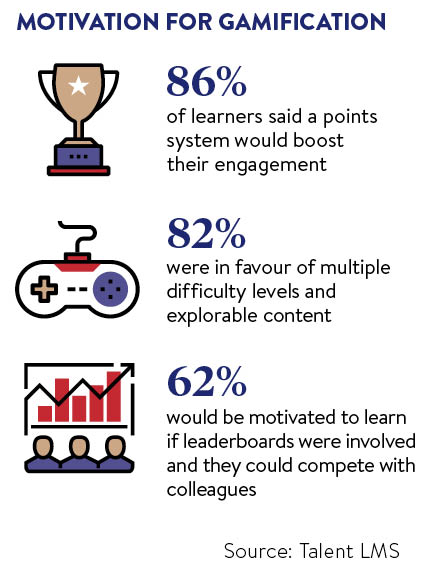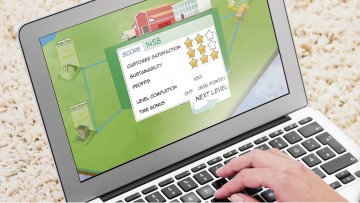A few years ago, it seemed like gamification was about to take over the world. The hype was everywhere and dramatic predictions for growth abounded.
Respected high-tech market research firm Gartner, for example, forecast that more than 70 per cent of Global 2000 organisations would have introduced at least one gamified application by 2015 due to the benefits they offer in terms of user motivation and engagement.
But as little as 18 months later, things had started to cool off. In fact, Gartner predicted at this point that by 2014 a huge 80 per cent of such applications would fail to meet business expectations as a result of poor design.
So just what is the truth of it today? According to Dr Karl Kapp, professor of instructional technology at Bloomsburg University of Pennsylvania and author of The Gamification of Learning and Instruction, the sector is now “out of the infant stage and towards the end of the toddler stage” in terms of market adoption.
Organisations are using gamification techniques for everything from staff inductions to helping encourage cultural change
Most big companies have implemented projects in pockets, primarily in areas such as sales and marketing, and learning and development (L&D). In the latter instance, they generally purchase learning management systems from vendors, such as Growth Engineering or Axonify, and add their own content.
But uptake is also growing elsewhere as some mid-range firms start purchasing more traditional applications that include gamified elements built in or can be hooked up to gamified platforms such as Badgeville.
Gamified e-learning systems
In the L&D space, gamified e-learning systems such as Kineo’s are the most popular option, says Pete Jenkins, founder of strategic consultancy Gamificationplus. But organisations are also using gamification techniques for everything from staff inductions to helping encourage cultural change.
In fact, L&D researcher Ambient Insight expects the gamified learning market, which it breaks down into four key categories, to nearly double in value from $8.7 billion in 2013 to $15 billion in 2018. These categories are game playing to achieve learning objectives; simulations to teach skills in an immersive environment; points, badges and leader boards as a means of motivation; and gamification, which it classifies as the use of rewards to motivate behaviour in a non-game context.
Mr Jenkins points out, however, that the use of the term “gamification” is progressively broadening to cover all of these classifications. “There are often misunderstandings as to what it actually is and so people will ask for a game,” he adds. “But what gamification is really about is using game mechanics and game-design techniques in a non-game situation.”
As for the failure rate of the first generation of initiatives, while perhaps not quite as high as predicted by Gartner, it still amounted to between 50 and 60 per cent, says Dr Kapp. A key issue here was that too many organisations simply added points, badges and leader boards to their existing content, and found people quickly became bored with them.
But the second generation of projects now under development or recently launched tend to be more sophisticated. “It’s about adding ideas such as stories, feedback loops, player experience and exploration,” says Dr Kapp. “It’s not enough to just add points for logging in – you have to give people an incentive, a mission and purpose.”
Motivation and incentive
Indeed research appears to indicate that to be truly effective, gamified learning needs to provide users with a mixture of intrinsic (internal) and extrinsic (external) motivation, he says.
 “Points, badges and leader boards were all about external motivation,” Dr Kapp explains. “But you have to offer a combination of both external and internal motivation, which is about helping someone to do something better and have them recognised for their accomplishment. This is what makes gamification most effective.”
“Points, badges and leader boards were all about external motivation,” Dr Kapp explains. “But you have to offer a combination of both external and internal motivation, which is about helping someone to do something better and have them recognised for their accomplishment. This is what makes gamification most effective.”
One firm that has attempted to go down this route is supply chain logistics company, Brambles, which operates in more than 60 countries. It introduced a game element into its Supply Chain Academy digital learning hub about a year ago to increase internal awareness of what the organisation does.
The academy is based on six classic online learning modules on different elements of the supply chain. But it also includes a standalone game called Ship It, based on technology from Learning Technologies Group’s Leo business and real-life scenarios, and input provided by an internal steering committee.
[embed_related]
Players must master four levels in which they plan optimal routes to make pick-ups and deliveries from a range of suppliers, distributors and retailers, while taking things like timescales, customer priorities, stock replenishment and truck capacity into consideration.

Supply chain game Ship It designed by LEO requires players to make pick-ups and deliveries while managing timescales, customers, stock, and truck capacity
Learning as they go, players can self-correct if they get something wrong and cause customer satisfaction to drop, profits to fall or carbon emissions to jump. But they are also awarded points for positive behaviours, which in turn are recorded on a leader board.
Although Ship It is referred to internally as a “simulation” so as not to “frighten people off” by associating it with a computer game, Lynne Rutherford, group vice president of L&D at Brambles, says: “It basically explains in a fun, very practical, active way what our business model is and what we do. So its uses are spreading through the organisation and we now use it for onboarding new starters too.”
Another approach that is starting to be discussed quite widely, meanwhile, is linking rewards with employee benefits. Dr Kapp explains: “To show progress and mastery, some organisations award badges. But the idea is that after awarding people so many badges, you could put them on a new salary schedule or give them a promotion. It’s not widespread, but there’s a lot of talk about it and definitely some pilots.”
Gareth Jones, chief technology officer at business management consultancy The Chemistry Group believes, however, that a third wave of even more sophisticated gamification initiatives is on the L&D horizon. The firm is currently working with SAP to create a logistics and resource management game not dissimilar to Ship It that will be posted to the careers element of the business application giant’s website in October at the same time as it launches a big recruitment campaign.
But the big difference between the two games is that SAP’s offering will act as a tool to collect data about individual players as part of a much bigger project. Mr Jones says: “It gives us an insight into their values and motivations, so whether they’re risk-averse or assertive, for instance, and how likely they are to behave in a certain way.”
The aim is to combine this information with data gleaned from social-media sites to create a profile of each candidate using machine-learning technology. Should they be successful in their application, this profile can subsequently be added to over the years based on activities ranging from e-learning to performance reviews.
The aim, says Mr Jones, is to “inform their learning and development journey in the business” by helping “us understand people’s learning styles, how to manage them, where to point them and the like”. Over time, enough data should have been gathered to make wider predictions about how each individual is likely to perform and what their ideal role would be as well as to fine-tune recruitment processes.
“No one is pulling all this information together at the moment, but the aim is to join up people’s data journey. To ensure it’s rich enough, we need lots of data points and game mechanics, if done properly, is a useful way to gather that data,” Mr Jones concludes.
CASE STUDY: HOUSE OF FRASER
One of House of Fraser’s plans for its gamified House of Learning environment is to link rewards such as badges with employee benefits to encourage positive behaviour among its staff.
House of Learning is an e-learning portal from Growth Engineering that includes a mix of training tools, such as a live chat function, to enable discussion with subject matter experts.

It also offers specific role-based learning paths for people from the time they first join the organisation to provide structured career development. As workers move up the different levels, they gain experience points and badges as rewards for completing different training elements and sharing their knowledge with others.
But the next step will be to take the reward system up a notch. Cheryl Daubney, House of Fraser’s digital design learning lead, explains: “In future, we’ll be exploring how to link things like points and badges to our House of Benefits system so that people will get House of Fraser vouchers if they post self-generated content, for example. It’s about recognising and encouraging certain behaviours, and it would add a whole new dimension.”
The UK-wide department store chain first rolled out the scheme to retail managers and staff at headquarters at the end of 2015, but plans to make it available to the rest of its 6,000 or so store workers by early-2017.
Gamified e-learning systems
Motivation and incentive







